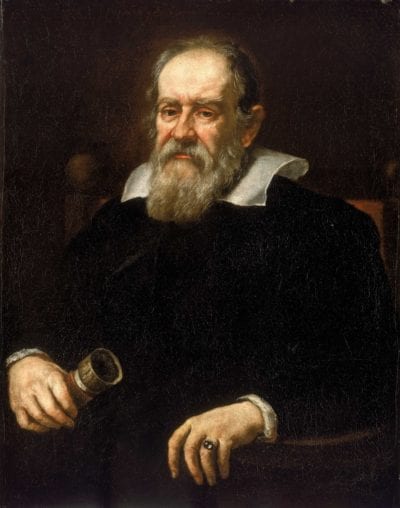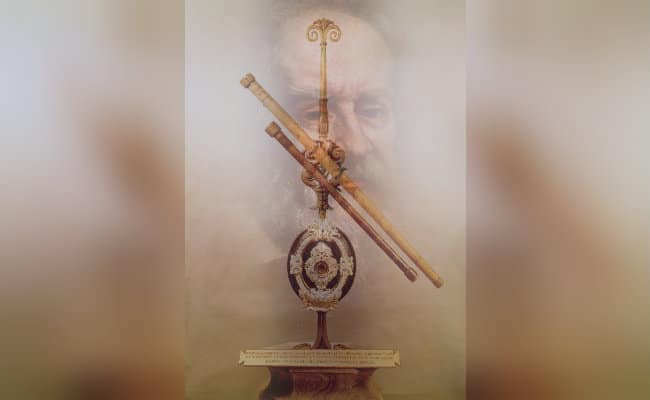The contributions of Galileo Galilei they were really vital for the development of physics, astronomy and science in general; since even this is considered the father of science, which according to studies was a physicist, engineer, mathematician, astronomer and philosopher who was born in Italy on February 15, 1564.
Galileo was a Catholic man according to the Renaissance movement, who was not only interested in the fields of science, but also in artistic expressions. Besides, it is considered that this was fundamental for the scientific revolution, since it challenged the ancient theories of both science and religion; where the latter was the cause of his confinement and subsequent death, since despite being a Catholic this was not a problem for him and his Copernican model of the universe.
Contribution to the Copernican theory

In ancient times, long before Galileo, it was only thought that God had created the Universe and therefore researchers only considered studying what was in it. According to the theories of Aristotle and Ptolemy, in conjunction with the Catholic Church, the earth was at the Center of the Universe and although that did not explain all the phenomena observed by students, it was a valid theory until the arrival of Copernicus, Galileo, Johannes Kepler and Tycho Brahe.
Galileo contributed to the Copernican theory (Planets revolve around the sun) the discoveries offered by his newly improved telescope, such as the observations he made of the Moon, Jupiter, Venus, and even the sun. What helped him to create a text that explained how the universe worked and what was the place of the earth in it.
Scientific revolution

One of the contributions of Galileo Galilei Most notable was his attitude towards the Catholic Church of wanting to go one step further and show that the model or theory that was had about the Universe was not correct, no matter how much it would cost.
This, together with his arrest, facilitated the way for other scientists to join and separate from the Catholic Church, producing a scientific revolution that allowed the development of science at a much greater speed than in previous times; reason why in a short time we managed to get to where we are today. Therefore, Galileo Galilei's contribution to the modern world is the greatest of all.
Galileo Galilei books
In the years of Galileo's life, he published a series of books about different fields, such as physics or astronomy. Among them we can find "The Sidereal Messenger" of 1610, "The operations of the geometric and military compass" of 1604, "Discourse about things that float on water" of 1612, "Dialogues on the two greatest systems of the world" of 1631 and "Two new sciences" of 1638.
- The sidereal messenger it is about the discoveries the scientist made about the moon.
- The operations of the geometric and military compass It consisted of the scientist's explanation of the experiments and applications to be used in the technological field.
- The book of speech about things that float on water, Rather, it consisted of an investigation that sought to verify Aristotle's theory, which was true.
- Dialogues on the two greatest systems in the world, It was about the different points of view about the theories of the Universe of the time; specifically there were three, the Copernican theory, the one that did not believe in it and the impartial one. The book develops with a person for each thought.
- Last Two new sciences aimed to make a summary about the sciences of motion and force, which were part of the Galileo Galilei's contributions to physics.
Law of motion
Newton's first law of motion was the object of study by Galileo, who understood that bodies can accelerate at the same rate regardless of their mass or size; so the movement was only about the speed and direction of a body.
According to Galileo, the movement was produced thanks to the application of a "force" and that if this was not part of the system, the body would be at "rest". Furthermore, it also concluded that objects are able to resist changes in their movement, therefore he discovered "inertia."

Telescope upgrade
Although this man did not invent the telescope, he did manage to improve it considerably. In those years, there was already a telescope that was capable of three times magnification, but Galileo managed to adjust the lenses to achieve a thirty-fold magnification.
The first telescope made headlines in 1609 and just a year later, this scientist had created more than fifty specimens (not all functional). In addition, also accommodate the image transmitted by this instrument, since previously it was seen flipped.
Saturn satellites
Galileo's contributions were extremely varied, since in this case he observed the satellites of Jupiter (he saw them for the first time in January 1610) through his telescope, believing that these were stars at first but later he understood that they were its satellites, which the closer they were to the planet, the faster they moved.
The phases of Venus

It was in the early 1600s when Galileo Galiei discovered the phases of Venus. The truth is that he had already observed the stars and Jupiter or Saturn. However, in this case he was able to verify that there were a series of phases that coincided with those of the moon. In this way, it is another of the great contributions of Galileo since they affirm, once again, the Copernican theory. For more than 1500 years, the theory was believed that both the sun, the planets and the moon were those that revolved around the earth. So when the phases of Venus were discovered, it was seen that everything that was thought was not compatible with this finding.
Jupiter's moons
The so-called moons of Jupiter were discovered in 1610 and of course, by Galileo Galilei. They were the four largest satellites that this planet had: Io, Europa, Ganymede and Callisto. Although he at first designated them with numbers. Galileo saw three points and the next day he discovered that there were four. They couldn't be stars because they were spinning around them.
Sunspots
Sunspots at that time were studied by a large number of scientists and researchers, so this attribution is wrongly given to Galileo because he used the discoveries of other scientists to attribute them and thus gain popularity and the respect of the monarchs. .
However, he also contributed to the study of them, which together with the other investigations allowed him to reinforce the Copernican theory, since these spots were an indication that the earth revolved around the sun.
The pendulum
Another of Galileo Galilei's contributions was the pendulum, since as a young man he observed the bells of Pisa Cathedral and how they oscillated thanks to the movement produced by air currents.
He created it in 1583 and by testing his pulse he managed to discover the “law of the pendulum”. Which is a principle that is still used today, which states that regardless of the distance a pendulum moves away from its balance, it does not vary in its oscillation.
Moon studies
The lunar studies by Galileo Galilei They are one of his most outstanding contributions in astronomy and science in general, since its movement and its characteristics were the object of study. From there the theory that our satellite was of our same nature was born (he observed mountains and craters in it), which gave him more reason to believe in the Copernican theory.
Thermoscope
Among the most outstanding inventions we find the thermoscope, since it was the first of its kind and this served for the creation of the thermometer that we know today. The invention was made in 1592, when Galileo used a small glass of water attached to a pipe that had an empty glass ball at the end. This worked according to temperature and pressure, since a result could be obtained with the union of both factors.
Although the thermoscope did not have the capacity to give an exact measurement about the temperature, it could indicate the changes of the same; So although it may not seem like a big deal today, at that time it was an innovative discovery that allowed the development of the measurement instruments of later years.
Scientific methodology
Galileo Galilei is also considered the father of the scientific method, which he presented in the period of conservatism of the Catholic religion and which in turn had no relationship with Aristotle's theories.
The finding was made when Galileo used mathematical proofs in some of his discoveries or investigations; which is considered a research tool. Despite not having mentioned it (there are doubts about why), this served for the later development of the scientific method.
Saturn's rings

He was the first astronomer to see Saturn from Earth. Investigating, he discovered something that caught his attention. It was nothing but the rings of Saturn. Although perhaps the fact as such is not a contribution to highlight, it is worth mentioning it.
Law of Fall
Again in the field of physics, this scientist innovated by showing that force caused acceleration and not speed as Aristotle said in antiquity; which allowed him to understand that the force of gravity is a constant force and that it produces a constant acceleration effect on bodies that fall towards the ground.
Galileo Galilei's contributions are not only incredible for the time in which he was, but also served as the basis for the development of science from that century to the present. Therefore, this is a character in history that is difficult to forget, since he dedicated all the years of his life to these discoveries that are so important for modern society and science.
Woou I don't know how to thank you seriously for your. Effort is worth a lot
.information has served me a lot and thank you for the effort thank you that you have made
All these ideas have benefited me in the research that I was doing thanks for everything
hello no mames you are a lesbian fucking with penises in hands
Very interesting I liked it
READING WHAT THE PAGE REPORTS ABOUT THIS CHARACTER, ONE IS PERPLEXED OF HIS GREAT WISDOM. SINCE THE TIME OF ITS EXISTENCE, ITS TEACHINGS AND ADVICE REMAIN VALID
It helped me a lot :)
that good
The information helped me a lot
It helped me a minute at school and I got twice as much homework. ??
It served me a lot, the physics class will now be lighter, thanks for your efforts
Thank you for this who made it worth 1000
I really liked the information and it helped me thank you.
I find this information confusing: Saturn satellites
Galileo's contributions were extremely varied, since in this case he observed the satellites of Jupiter
Thank you very much for the information
haha send: v
It was an extraordinary document of the work that this extraordinary genius left for posterity who contributed a lot to humanity and modern science and who helped me enormously for an investigation that the Galileo University left me here in Guatemala on the life and work of Galileo Galilei . Very grateful to this post.